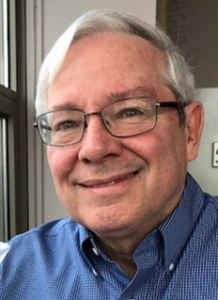
Professor Van Harlingen received his bachelor’s degree in physics in 1972, and his Ph.D. in physics in 1977, from The Ohio State University. His thesis title was “Thermoelectric Flux Effects in Superconducting Indium”. After a year as a NATO postdoctoral fellow in the Cavendish Laboratory at the University of Cambridge, England, with Professor John Waldram, he held a postdoctoral research position at the University of California at Berkeley for three years, where he worked on non-equilibrium superconductivity and dc SQUID electronics with Professor John Clarke. He joined the Department of Physics faculty at the University of Illinois as an assistant professor in 1981, was promoted to associate professor in 1988, and to professor in 1994. He is currently the Center for Advanced Study Professor of Physics and the Donald Biggar Willett Professor of Engineering at the University of Illinois. Professor Van Harlingen became a member of the American Physical Society in 1975 and a Fellow in 1996. He received the prestigious Oliver E. Buckley Prize in Condensed Matter Physics from the APS in 1998 and was elected a member of the American Academy of Arts and Sciences in 1999 and to the National Academy of Sciences in 2003. He served as Head of the Department of Physics from 2006-2018, and is currently the Executive Associate Director of the Illinois Quantum Information Science and Technology Center.
Research Description
Our research program on superconductor materials and devices is “effect-oriented” in that instead of focusing on one class of materials, or specializing on one experimental technique, we look at a wide range of systems and utilize multiple techniques required to elucidate the science. Our core techniques are cryogenics, growth of this films by evaporation, sputtering and PLD, micro/nanofabrication, and electronic transport properties over a wide spectrum of frequencies and magnetic fields. In addition, we specialize in several advanced techniques that we have found can give unique information about complex systems. We are probably best known for phase-sensitive probes based on Josephson and SQUID interferometry for measuring the pairing symmetry of unconventional superconductors and the current-phase relation of unconventional Josephson junctions. We also have been in involved in the development and use of Scanning SQUID Microscopy and related scanning probes. In addition, we have been a proponent of noise spectroscopy to reveal dynamical information.
We currently study materials and devices incorporating both classic and unconventional superconductors. Part of our program is to study topological excitations such as Majorana fermion states in hybrid superconductor-topological insulator Josephson junctions, primarily Nb for the superconductor and Bi2Se3 for the TI. This work also uses Al-AlOx-Al shadow-evaporated junctions for SET parity detectors. We are also studying candidates for topological superconductivity: CuxBi2Se3 and NbxBi2Se3, and candidate for higher-order topological states such as Bi, SnTe, and FeSexTe1-x. In our work on unconventional superconductors and Josephson current-phase relations, we are studying La2-xSrxCuO4, La2-xBaxCu, Sr2Ru2O4, UPt3, FeSexTe1-x, UTe2, PrOs4Sb12, and bilayer and trilayer graphene.

